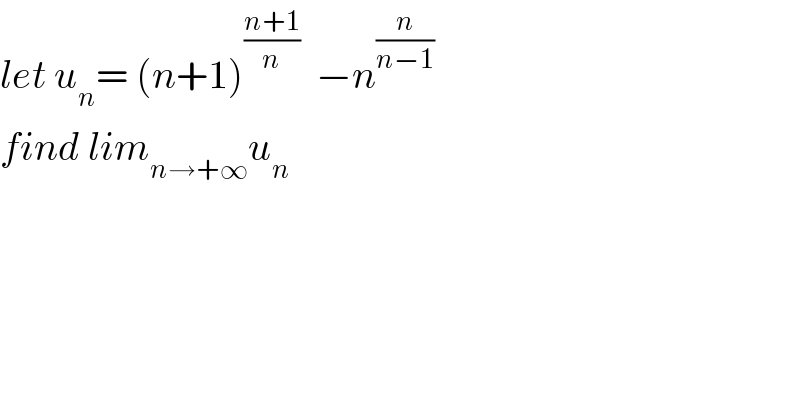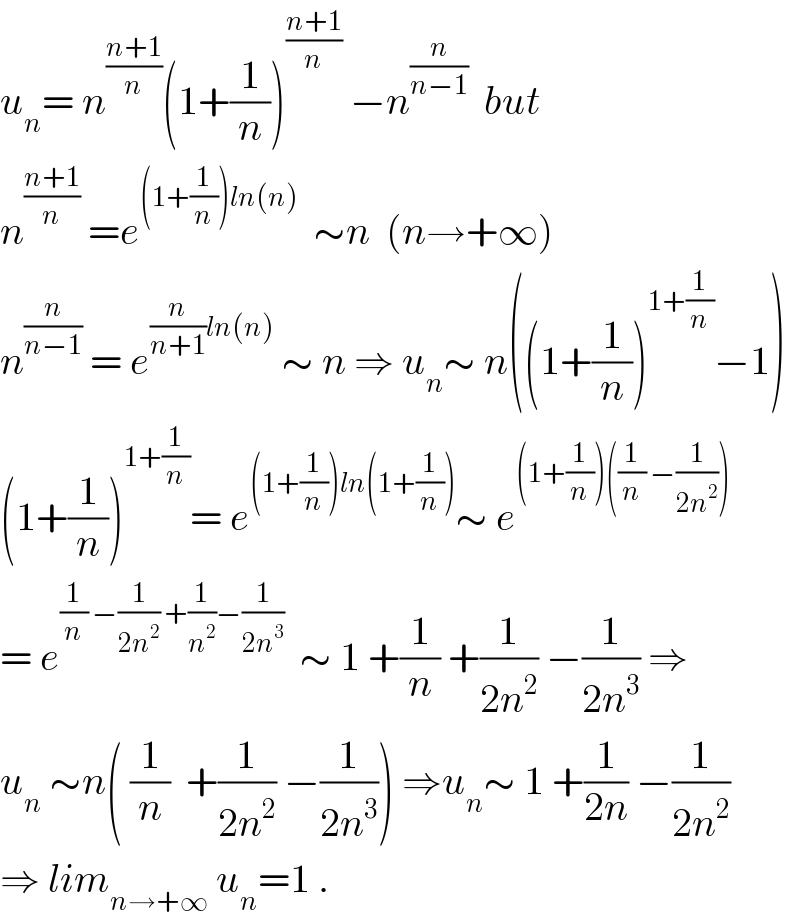
Previous in Relation and Functions Next in Relation and Functions
Question Number 34226 by abdo imad last updated on 03/May/18

$${let}\:{u}_{{n}} =\:\left({n}+\mathrm{1}\right)^{\frac{{n}+\mathrm{1}}{{n}}} \:\:−{n}^{\frac{{n}}{{n}−\mathrm{1}}} \\ $$$${find}\:{lim}_{{n}\rightarrow+\infty} {u}_{{n}} \\ $$
Commented by abdo mathsup 649 cc last updated on 05/May/18

$${u}_{{n}} =\:{n}^{\frac{{n}+\mathrm{1}}{{n}}} \left(\mathrm{1}+\frac{\mathrm{1}}{{n}}\right)^{\frac{{n}+\mathrm{1}}{{n}}} \:−{n}^{\frac{{n}}{{n}−\mathrm{1}}} \:\:{but} \\ $$$${n}^{\frac{{n}+\mathrm{1}}{{n}}} \:={e}^{\left(\mathrm{1}+\frac{\mathrm{1}}{{n}}\right){ln}\left({n}\right)} \:\:\sim{n}\:\:\left({n}\rightarrow+\infty\right) \\ $$$${n}^{\frac{{n}}{{n}−\mathrm{1}}} \:=\:{e}^{\frac{{n}}{{n}+\mathrm{1}}{ln}\left({n}\right)} \:\sim\:{n}\:\Rightarrow\:{u}_{{n}} \sim\:{n}\left(\left(\mathrm{1}+\frac{\mathrm{1}}{{n}}\right)^{\mathrm{1}+\frac{\mathrm{1}}{{n}}} −\mathrm{1}\right) \\ $$$$\left(\mathrm{1}+\frac{\mathrm{1}}{{n}}\right)^{\mathrm{1}+\frac{\mathrm{1}}{{n}}} =\:{e}^{\left(\mathrm{1}+\frac{\mathrm{1}}{{n}}\right){ln}\left(\mathrm{1}+\frac{\mathrm{1}}{{n}}\right)} \sim\:{e}^{\left(\mathrm{1}+\frac{\mathrm{1}}{{n}}\right)\left(\frac{\mathrm{1}}{{n}}\:−\frac{\mathrm{1}}{\mathrm{2}{n}^{\mathrm{2}} }\right)} \\ $$$$=\:{e}^{\frac{\mathrm{1}}{{n}}\:−\frac{\mathrm{1}}{\mathrm{2}{n}^{\mathrm{2}} }\:+\frac{\mathrm{1}}{{n}^{\mathrm{2}} }−\frac{\mathrm{1}}{\mathrm{2}{n}^{\mathrm{3}} }} \:\:\sim\:\mathrm{1}\:+\frac{\mathrm{1}}{{n}}\:+\frac{\mathrm{1}}{\mathrm{2}{n}^{\mathrm{2}} }\:−\frac{\mathrm{1}}{\mathrm{2}{n}^{\mathrm{3}} }\:\Rightarrow \\ $$$${u}_{{n}} \:\sim{n}\left(\:\frac{\mathrm{1}}{{n}}\:\:+\frac{\mathrm{1}}{\mathrm{2}{n}^{\mathrm{2}} }\:−\frac{\mathrm{1}}{\mathrm{2}{n}^{\mathrm{3}} }\right)\:\Rightarrow{u}_{{n}} \sim\:\mathrm{1}\:+\frac{\mathrm{1}}{\mathrm{2}{n}}\:−\frac{\mathrm{1}}{\mathrm{2}{n}^{\mathrm{2}} } \\ $$$$\Rightarrow\:{lim}_{{n}\rightarrow+\infty} \:{u}_{{n}} =\mathrm{1}\:. \\ $$
